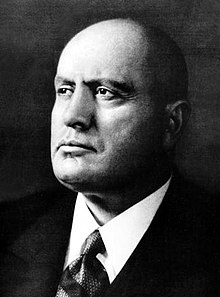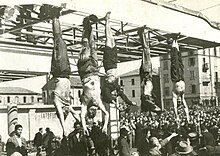Benito Mussolini

Benito Mussolini | |
|---|---|
 Official Portrait | |
| 27th Prime Minister of Italy | |
| In office 31 October 1922 – 25 July 1943 | |
| Monarch | Victor Emmanuel III |
| Preceded by | Luigi Facta |
| Succeeded by | Pietro Badoglio |
| Duce of the Italian Social Republic | |
| In office 23 September 1943 – 25 April 1945 | |
| Duce of Fascism | |
| In office 23 March 1919 – 28 April 1945 | |
| Minister of Foreign Affairs | |
| In office 5 February 1943 – 25 July 1943 | |
| Preceded by | Galeazzo Ciano |
| Succeeded by | Raffaele Guariglia |
| In office 20 July 1932 – 9 June 1936 | |
| Preceded by | Dino Grandi |
| Succeeded by | Galeazzo Ciano |
| In office 30 October 1922 – 12 September 1929 | |
| Preceded by | Carlo Schanzer |
| Succeeded by | Dino Grandi |
| Minister of the Colonies | |
| In office 20 November 1937 – 31 October 1939 | |
| Preceded by | Alessandro Lessona |
| Succeeded by | Attilio Teruzzi |
| In office 17 January 1935 – 11 June 1936 | |
| Preceded by | Emilio De Bono |
| Succeeded by | Alessandro Lessona |
| In office 18 December 1928 – 12 September 1929 | |
| Preceded by | Luigi Federzoni |
| Succeeded by | Emilio De Bono |
| Minister of War | |
| In office 22 July 1933 – 25 July 1943 | |
| Preceded by | Pietro Gazzera |
| Succeeded by | Antonio Sorice |
| In office 4 April 1925 – 12 September 1929 | |
| Preceded by | Antonino Di Giorgio |
| Succeeded by | Pietro Gazzera |
| Minister of the Interior | |
| In office 6 November 1926 – 25 July 1943 | |
| Preceded by | Luigi Federzoni |
| Succeeded by | Bruno Fornaciari |
| In office 31 October 1922 – 17 June 1924 | |
| Preceded by | Paolino Taddei |
| Succeeded by | Luigi Federzoni |
| Member of the Chamber of Deputies | |
| In office 11 June 1921 – 2 August 1943 | |
| Personal details | |
| Born | Benito Amilcare Andrea Mussolini 29 July 1883 Predappio, Kingdom of Italy |
| Died | 28 April 1945 (aged 61) Giulino di Mezzegra, Kingdom of Italy |
| Cause of death | Execution by firing squad |
| Resting place | San Cassiano cemetery, Predappio, Italy |
| Nationality | Italian |
| Political party | National Fascist Party (1921–1943) |
| Other political affiliations |
|
| Height | 1.70 m (5 ft 7 in) |
| Spouse(s) |
|
| Relations | |
| Children |
|
| Parents | |
| Relatives | Mussolini family |
| Profession | Politician, journalist, novelist, teacher |
| Signature | |
| Military service | |
| Allegiance | |
| Branch/service | |
| Years of service | 1915–1917 (active) |
| Rank | |
| Unit | 11th Bersaglieri Regiment |
| Battles/wars | |
Benito Amilcare Andrea Mussolini KSMOM GCTE (29 July 1883 – 28 April 1945) was an Italian politician and journalist who served as Prime Minister of Italy from 1922 to 1943. He also was the leader of the National Fascist Party.
Biography[change | change source]
Early life[change | change source]

Benito Mussolini was named after Benito Juarez, a Mexican opponent of the political power of the Roman Catholic Church, by his anticlerical (a person who opposes the political interference of the Roman Catholic Church in secular affairs) father.[1] Mussolini's father was a blacksmith.[2] Before being involved in politics, Mussolini was a newspaper editor (where he learned all his propaganda skills) and elementary school teacher.[3]
At first, Mussolini was a socialist, but when he wanted Italy to join the First World War, he was thrown out of the socialist party. He 'invented' a new ideology, Fascism, much out of Nationalist and Conservative views.
Rise to power and becoming dictator[change | change source]

In 1922, he took power by having a large group of men, "Black Shirts," march on Rome and threaten to take over the government. King Vittorio Emanuele III gave in, allowed him to form a government, and made him prime minister. In the following five years, he gained power, and in 1927 created the OVRA, his personal secret police force. Using the agency to arrest, scare, or murder people against his regime, Mussolini was dictator of Italy by the end of 1927. Only the King and his own Fascist party could challenge his power.
Fascism as practiced by Mussolini[change | change source]

Mussolini's form of Fascism, "Italian Fascism"- unlike Nazism, the racist ideology that Adolf Hitler followed- was different and less destructive than Hitler's. Although a believer in the superiority of the Italian nation and national unity, Mussolini, unlike Hitler, is quoted "Race? It is a feeling, not a reality. Nothing will ever make me believe that biologically pure races can be shown to exist today".[4]
Mussolini wanted Italy to become a new Roman Empire. In 1923, he attacked the island of Corfu, and in 1924, he occupied the city state of Fiume. In 1935, he attacked the African country Abyssinia (now called Ethiopia). His forces occupied it in 1936. Italy was thrown out of the League of Nations because of this aggression. In 1939, he occupied the country Albania. In 1936, Mussolini signed an alliance with Adolf Hitler, the dictator of Germany.
Fall from power and death[change | change source]

In 1940, he sent Italy into the Second World War on the side of the Axis countries. Mussolini attacked Greece, but he failed to conquer it. In 1943, the Allies landed in Southern Italy. The Fascist party and King Vittorio Emanuel III deposed Mussolini and put him in jail, but he was set free by the Germans, who made him ruler of the Italian Social Republic puppet state which was in a small part of Central Italy. When the war was almost over, Mussolini tried to escape to Switzerland with his mistress, Clara Petacci, but they were both captured and shot by partisans. Mussolini's dead body was hanged upside-down, together with his mistress and some of Mussolini's helpers, on a pole at a gas station in the village of Milan, which is near the border between Italy and Switzerland.
After death[change | change source]
After the war, several Neo-Fascist movements have had success in Italy, the most important being the Movimento Sociale Italiano. His granddaughter Alessandra Mussolini has outspoken views similar to Fascism.
Legacy[change | change source]

Mussolini's legacy is complex; he played a significant role in Italian history, but his association with fascism and authoritarianism has left a controversial mark. His policies had lasting effects, but they were often accompanied by suppression of dissent and human rights abuses.
Sources[change | change source]
- ↑ Brendon, Piers The Dark Valley: A Panorama of the 1930s Vintage Books 2000 page 128
- ↑ Mussolini, Benito (1998) My Rise and Fall Da Capo Press page 3
- ↑ Mussolini, Benito My Rise and Fall Da Capo Press 1998 pages 11-12
- ↑ http://www.kennethbillings.org/mussolini.html Archived 2013-09-08 at the Wayback Machine 1941 book "Dictators and Democrats"
Other websites[change | change source]
- Mussolini's "Last Will", April 22, 1945 (in Italian). From 'Il Giornale' newspaper Archived July 22, 2011, at the Wayback Machine

